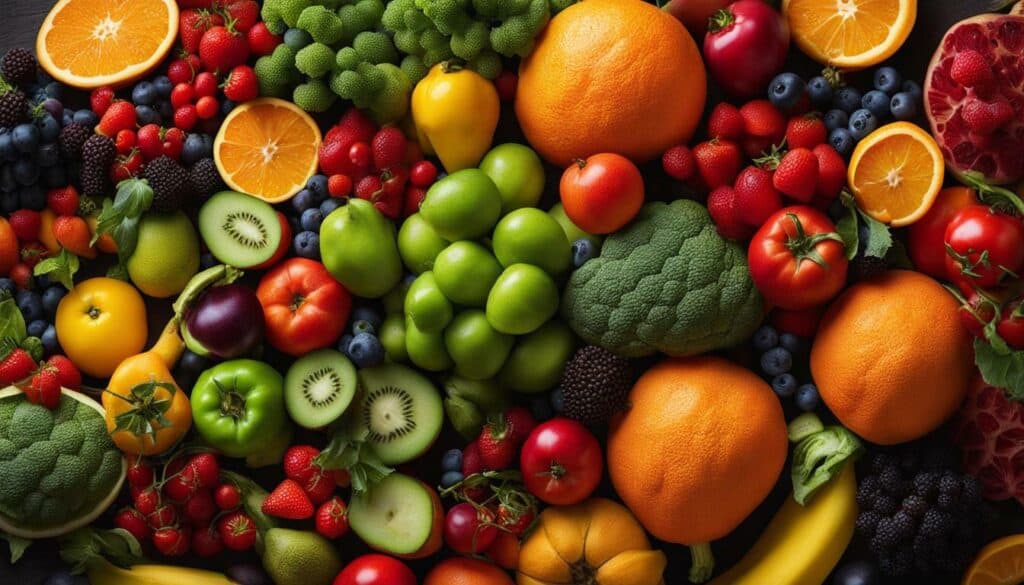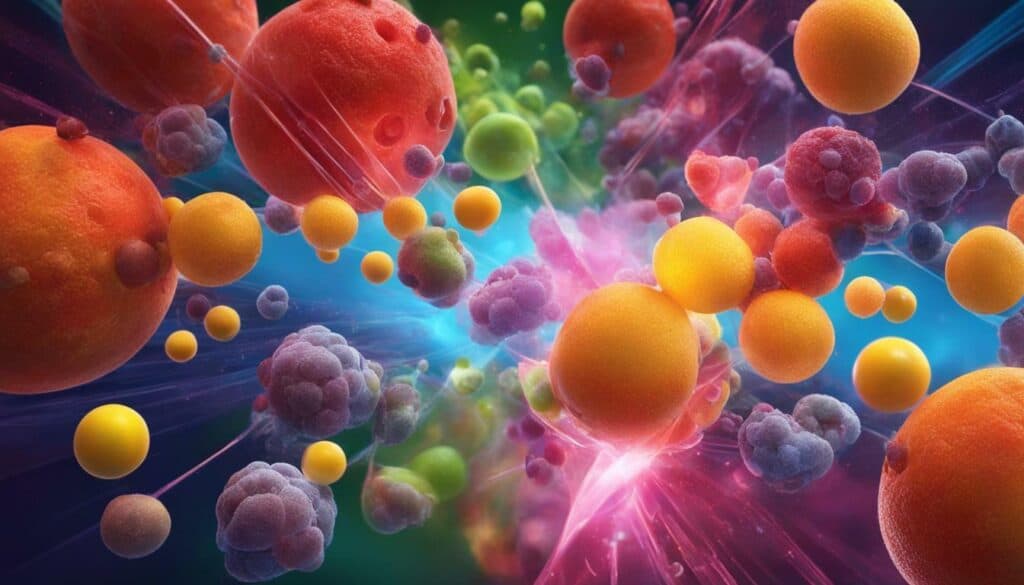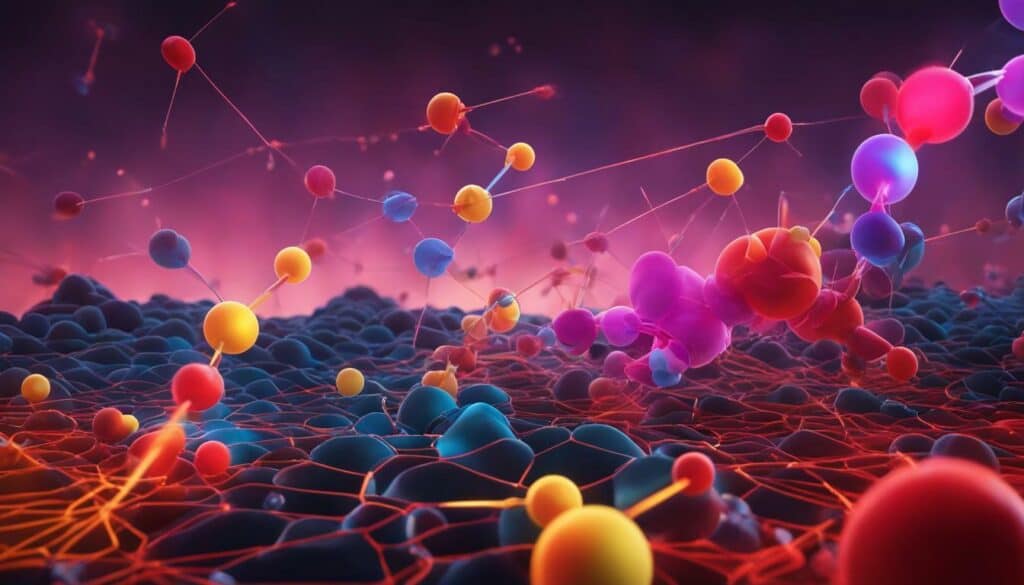Welcome to my carbohydrates pictures gallery, where we will unveil the mysteries of your diet and learn about the fascinating world of carbohydrates. Carbohydrates are a large group of compounds found in foods and living tissues, including sugars, starch, and cellulose. They contain hydrogen and oxygen in the same ratio as water and can be broken down in an animal’s body to release energy.
Carbohydrates are made up of chains of glucose molecules, and one type of carbohydrate is known as starch, which is a reserve supply of energy for plants. Carbohydrates play a crucial role in maintaining and enhancing health and can impact the body, metabolism, mood, and energy levels.
- Carbohydrates are a diverse group of compounds found in foods and living tissues.
- They provide energy for the body and play a crucial role in maintaining health.
- Complex carbohydrates, such as whole grains and vegetables, are the healthier choice.
- Simple carbohydrates, found in sugary treats, should be consumed in moderation.
- Carbohydrates are an essential part of a balanced diet and should not be eliminated completely.
Now that we’ve delved into the fascinating world of carbohydrates, you have a better understanding of their importance in your diet. Stay tuned as we explore the structure and types of carbohydrates in our next section!
Understanding Carbohydrates: Structure and Types
To truly understand carbohydrates, let’s start by exploring their unique structures and the various types they can be classified into. Carbohydrates are a large group of compounds found in foods and living tissues, including sugars, starch, and cellulose. They play a crucial role in maintaining and enhancing our health, providing us with the energy we need for our daily activities.
Carbohydrates are made up of chains of glucose molecules, which are simple sugars. These chains can be branched or linear, giving rise to the different structures of carbohydrates. One type of carbohydrate is known as starch, which serves as a reserve supply of energy for plants. Starch is composed of two distinct polymers: amylose and amylopectin. Amylose is a linear chain of glucose molecules, while amylopectin is a branched chain.
In addition to starch, carbohydrates can be classified into other types, such as monosaccharides and disaccharides. Monosaccharides are the simplest form of carbohydrates and include glucose, fructose, and galactose. Disaccharides, on the other hand, are formed by the combination of two monosaccharide molecules. Examples of disaccharides include sucrose, lactose, and maltose.

Understanding the structure and types of carbohydrates is crucial for making informed dietary choices. By incorporating a variety of carbohydrates into our diets, we can ensure that we are providing our bodies with the necessary nutrients for optimal health and well-being.
Key Takeaways:
- Carbohydrates are a group of compounds found in foods and living tissues.
- They are made up of chains of glucose molecules.
- Starch is a type of carbohydrate that serves as a reserve supply of energy for plants.
- Carbohydrates can be classified into monosaccharides, disaccharides, and other types.
- Understanding the structure and types of carbohydrates is important for making healthy dietary choices.
| Type of Carbohydrate | Example |
|---|---|
| Monosaccharides | Glucose |
| Disaccharides | Sucrose |
| Starch | Amylose |
Complex Carbohydrates: The Powerhouses of Nutrition
Complex carbohydrates are an essential part of a healthy diet, providing sustained energy and essential nutrients. Let’s explore the world of complex carbohydrates and the array of delicious foods they encompass.
Complex carbohydrates are made up of long chains of sugar molecules, which take longer to break down in the body compared to simple carbohydrates. This slow digestion process helps regulate blood sugar levels, providing a steady release of energy throughout the day. Additionally, complex carbohydrates are rich in fiber, vitamins, and minerals, making them an excellent choice for overall health and well-being.
When it comes to complex carbohydrates, whole grains, legumes, and starchy vegetables are some of the top contenders. Whole wheat bread, brown rice, quinoa, beans, lentils, sweet potatoes, and oats are all great sources of complex carbs. These foods not only provide energy but also offer important nutrients like B vitamins, iron, and antioxidants.

Incorporating complex carbohydrates into our meals can be both delicious and nutritious. From a hearty bowl of whole grain pasta with fresh vegetables to a comforting lentil stew, there are endless possibilities to enjoy complex carbs. Adding these wholesome foods to our diet can support our overall health, promote digestion, and help maintain a balanced weight.
Benefits of Complex Carbohydrates:
- Provide sustained energy
- Help regulate blood sugar levels
- Rich in fiber, vitamins, and minerals
- Promote digestive health
- Support a balanced weight
As we explore the world of complex carbohydrates, let’s remember to incorporate them into our daily meals for a well-rounded and nourishing diet.
Unveiling Simple Carbohydrates: Sweet and Simple
While simple carbohydrates are often seen as indulgent treats, they are also found in natural foods and can provide quick bursts of energy. Let’s uncover the world of simple carbohydrates and explore their diverse sources.
Simple carbohydrates, also known as sugars, are composed of one or two sugar molecules. They are easily broken down by the body, leading to a rapid release of glucose into the bloodstream. This quick energy boost can be beneficial during intense physical activities or to alleviate fatigue.
Some common sources of simple carbohydrates include fruits, vegetables, dairy products, and honey. These natural foods not only provide carbohydrates but also offer essential vitamins, minerals, and fiber. Choosing whole foods rich in simple carbohydrates can be a healthier option compared to processed sweets, as they provide additional nutritional benefits.

Incorporating simple carbohydrates into a well-balanced diet can help you maintain a steady supply of energy throughout the day. However, it is important to consume them in moderation and alongside complex carbohydrates and proteins to support overall health and blood sugar control.
Now that we have explored the world of simple carbohydrates, it’s time to dive deeper into the intricate topic of complex carbohydrates, the powerhouses of nutrition. Stay tuned for the next section where we will discover the benefits of complex carbohydrates and explore captivating pictures of healthy carbohydrate-rich foods.
Diverse Sources of Simple Carbohydrates
| Food Source | Simple Carbohydrate Content |
|---|---|
| Fruits (such as bananas, oranges, and grapes) | Fructose |
| Dairy products (such as milk and yogurt) | Lactose |
| Honey and maple syrup | Fructose and glucose |
| White sugar and brown sugar | Sucrose |
| Refined grains (such as white bread and pasta) | Glucose |
As you can see from the table, simple carbohydrates can be found in a variety of everyday foods. The key is to choose natural sources that offer additional nutritional value and to consume them in moderation as part of a balanced diet.
High Carbohydrate Foods: Fueling Your Body
High carbohydrate foods can be a valuable source of energy for athletes, active individuals, and those looking to maintain a balanced diet. Join me in exploring a range of high carbohydrate foods and their incredible nutritional properties.
One popular high carbohydrate food is bananas. Not only are they delicious, but they also provide a quick and natural energy boost. Bananas are packed with easily digestible carbohydrates, making them an ideal snack before or after a workout. They are also rich in potassium, which helps prevent muscle cramps. Whether sliced into a bowl of oatmeal or enjoyed on their own, bananas are a versatile and nutritious choice.
Another high carbohydrate food that can fuel your body is sweet potatoes. These vibrant root vegetables are packed with complex carbohydrates, fiber, and essential vitamins and minerals. Sweet potatoes have a lower glycemic index compared to regular potatoes, meaning they release glucose into the bloodstream at a slower pace, providing a steady energy supply. Roasted, mashed, or in salads, sweet potatoes add a sweet and nutritious touch to any meal.
Whole grains are also an excellent source of high-quality carbohydrates. Foods like quinoa, brown rice, and whole wheat bread are packed with fiber, vitamins, and minerals. They provide a sustained release of energy, keeping you feeling full and satisfied for longer periods. Incorporating whole grains into your diet can support weight management and promote overall health.
| High Carbohydrate Foods | Nutritional Benefits |
|---|---|
| Bananas | Quick energy boost, potassium |
| Sweet potatoes | Complex carbohydrates, fiber, vitamins, minerals |
| Whole grains | Fiber, sustained energy, weight management |
“High carbohydrate foods provide the necessary fuel for our bodies to function optimally, especially during physical activities. When choosing high carbohydrate foods, opt for whole and unprocessed options to maximize nutritional benefits.” – Nutritionist Emma Johnson
In conclusion, high carbohydrate foods are an essential part of a balanced diet. They provide the energy needed for physical activities and support overall health. From bananas and sweet potatoes to whole grains, there are numerous delicious options to choose from. Remember to incorporate these high carbohydrate foods into your meals and snacks to maintain an active and healthy lifestyle.

Understanding how carbohydrates are metabolized in our bodies is crucial for optimizing energy levels and maintaining overall health. Let’s delve into the fascinating world of carbohydrate metabolism and discover its impact on our well-being.
Carbohydrate metabolism refers to the process by which our bodies break down carbohydrates into glucose, which is then used as a primary source of energy. This intricate process involves various enzymatic reactions, transport mechanisms, and metabolic pathways that ensure our cells receive the necessary fuel for their proper functioning.
One of the key steps in carbohydrate metabolism is glycolysis, where glucose is converted into pyruvate through a series of enzymatic reactions. This process occurs in the cytoplasm of our cells and generates a small amount of ATP, the energy currency of our bodies.
To further extract energy from glucose, aerobic respiration takes place in the mitochondria. Here, pyruvate is converted into acetyl-CoA, which enters the citric acid cycle (also known as the Krebs cycle). During this cycle, more ATP is produced, along with carbon dioxide and high-energy electron carriers that will be utilized in the electron transport chain to generate additional ATP.
Throughout the process of carbohydrate metabolism, our bodies carefully regulate and maintain blood glucose levels to meet the energy demands of different tissues. Insulin and glucagon, hormones produced by the pancreas, play a crucial role in this regulation. Insulin facilitates the uptake and storage of glucose, while glucagon promotes the breakdown of stored glycogen to release glucose into the bloodstream when needed.
Now that we have a basic understanding of carbohydrate metabolism, let’s take a moment to appreciate the complexity and beauty of this vital process. Carbohydrates are truly the fuel that powers our bodies, and their metabolism ensures that we have the energy necessary for our daily activities.

Table 1: Key Steps in Carbohydrate Metabolism
| Step | Location | Process |
|---|---|---|
| Glycolysis | Cytoplasm | Conversion of glucose into pyruvate, with the production of ATP |
| Aerobic Respiration | Mitochondria | Conversion of pyruvate into acetyl-CoA, followed by the citric acid cycle and electron transport chain to generate ATP |
| Glycogenolysis | Liver and muscles | Breakdown of stored glycogen into glucose for energy release |
| Gluconeogenesis | Liver | Synthesis of glucose from non-carbohydrate precursors when glucose levels are low |
The Impact of Carbohydrates on Health and Well-being
Carbohydrates are more than just a source of energy; they have a profound impact on our overall health and well-being. Let’s delve into the ways carbohydrates influence our metabolism, mood, and energy levels, and explore engaging pictures that illustrate these effects.
When it comes to metabolism, carbohydrates play a vital role. They are broken down into glucose, which is the primary source of fuel for our bodies. Consuming a balanced diet that includes healthy carbohydrates, such as whole grains, fruits, and vegetables, can help regulate blood sugar levels and provide sustained energy throughout the day. This steady release of energy helps to keep us focused, productive, and maintains our overall well-being.
Carbohydrates also have a direct impact on our mood. The consumption of carbohydrates triggers the release of serotonin, a neurotransmitter that promotes feelings of happiness and relaxation. That’s why we often crave carbohydrates when we’re feeling down or stressed. However, it’s important to choose complex carbohydrates like whole grains and legumes, rather than simple carbohydrates found in sugary snacks, for long-lasting mood stability.
Now let’s take a visual journey through the effects of carbohydrates on our energy levels. Feast your eyes on these captivating pictures that showcase the nutritious and delicious world of healthy carbohydrates. Whether it’s a vibrant bowl of fresh fruits, a hearty plate of whole grain pasta, or a colorful salad bursting with nutritious ingredients, these images will inspire you to make wholesome choices that fuel your body and support your well-being.
| Food | Carbohydrate Content (per 100g) |
|---|---|
| Quinoa | 21g |
| Black beans | 62g |
| Oats | 56g |
| Sweet potato | 20g |
| Brown rice | 23g |
As you can see, these healthy carbohydrate-rich foods are not only delicious but also provide the energy your body needs to thrive. So, embrace the power of carbohydrates and make informed choices that support your health and well-being!
References
- Liu, J., Li, M., Luo, Z., Wu, J., Liu, H., Li, H., & Cai, J. (2020). Carbohydrate metabolism in cancer: molecular mechanisms and therapeutic potential. EMBO Journal, 39(15), e103102. doi: 10.15252/embj.2019103102
- Thomas, D. T., Erdman, K. A., & Burke, L. M. (2016). Position of the Academy of Nutrition and Dietetics, Dietitians of Canada, and the American College of Sports Medicine: Nutrition and Athletic Performance. Journal of the Academy of Nutrition and Dietetics, 116(3), 501-528. doi: 10.1016/j.jand.2015.12.006

Exploring Carbohydrates in Nature: Starch as a Reserve Energy
Starch is a vital carbohydrate found in plants, serving as a reserve supply of energy crucial for plant growth and development. Join me in exploring the fascinating world of starch and discovering its importance in the natural world.
Derived from glucose molecules, starch is a complex carbohydrate that plants store as granules in their cells. These granules serve as a valuable energy source, providing fuel for plants during times of growth or metabolic activity. By breaking down starch, plants can convert it into glucose, which can then be used to produce ATP, the energy currency of the cell.

The structure of starch consists of two forms: amylose and amylopectin. Amylose is a linear chain of glucose molecules, while amylopectin has a branched structure. These different structures affect the digestibility and functionality of starch in both plants and animals.
In the plant kingdom, starch is commonly found in grains, such as rice and wheat, as well as in root vegetables like potatoes. It serves as a storage form of energy, enabling plants to survive periods of limited sunlight or unfavorable conditions. Starch is also a major component of many staple foods in human diets, providing us with the energy we need for daily activities.
As we continue our journey through the world of carbohydrates, let’s appreciate the role that starch plays in sustaining life and fueling the growth and development of plants. Now that we understand the importance of starch as a reserve energy source, we can truly appreciate the wonders of nature and the intricate mechanisms behind the sustenance of life.
Lectin-Carbohydrate Interactions: Implications for Antiviral Agents
Lectin-carbohydrate interactions have captured the attention of researchers seeking to develop effective antiviral agents. In this section, we will explore the fascinating world of these interactions and the potential of carbohydrates in combating viruses.
Carbohydrates play a crucial role in the immune system by acting as recognition molecules. Specific carbohydrates on the surface of pathogens, such as viruses, can bind to lectins, which are proteins that have the ability to recognize and bind to specific carbohydrate molecules. This binding initiates a series of events that can lead to the neutralization or destruction of the pathogen.
In the search for potential antiviral agents, researchers have focused on understanding the specific interactions between lectins and carbohydrates. By studying the structure and binding properties of lectins, scientists can design molecules that mimic the carbohydrate structures on pathogens, inhibiting the binding of lectins and preventing viral infection. This approach has shown promise in the development of antiviral therapies, particularly against HIV.
| Lectin | Virus | Antiviral Activity |
|---|---|---|
| Cyanovirin-N (CV-N) | HIV | Inhibits viral entry into host cells by binding to high mannose glycans on the viral envelope |
One example of a lectin with antiviral activity is Cyanovirin-N (CV-N), a cyanobacterial lectin that binds to high mannose glycans on the envelope of HIV. By interacting with these carbohydrates, CV-N blocks viral entry into host cells, preventing the spread of the virus.
“The specific interactions between lectins and carbohydrates have been studied using various techniques, including NMR spectroscopy, crystallography, and molecular dynamics simulations. These studies have revealed the intricate hydrogen bonding networks involved in the binding process, providing valuable insights for the design of antiviral agents.”
The specific interactions between lectins and carbohydrates have been studied using various techniques, including NMR spectroscopy, crystallography, and molecular dynamics simulations. These studies have revealed the intricate hydrogen bonding networks involved in the binding process, providing valuable insights for the design of antiviral agents.
By unraveling the mysteries of lectin-carbohydrate interactions, scientists are paving the way for the development of novel antiviral therapies. Carbohydrates, with their diverse structures and functions, hold tremendous potential in combating viruses and improving human health.

Through this comprehensive exploration of carbohydrates, we have unveiled the mysteries of nutrition and discovered the vital role that carbohydrates play in our health and well-being. Carbohydrates, such as sugars, starch, and cellulose, are found in various foods and living tissues. They provide the body with energy by breaking down into glucose molecules.
One type of carbohydrate, known as starch, acts as a reserve supply of energy for plants. Incorporating complex carbohydrates into our diets, like those found in whole grains, fruits, and vegetables, can have a positive impact on our overall health. These foods not only provide sustained energy but also essential nutrients, vitamins, and minerals.
Carbohydrates have the power to influence our metabolism, mood, and energy levels. They are crucial for maintaining a balanced diet and fueling an active lifestyle. By understanding carbohydrate metabolism, we can optimize our body’s energy release and make informed choices about the foods we consume.
Furthermore, recent research into lectin-carbohydrate interactions, such as the cyanobacterial lectin Cyanovirin-N, has shown promise in the development of antiviral agents. Scientists have studied the specific binding process, exploring hydrogen bonding networks and molecular dynamics simulations, to better understand the potential of carbohydrates in combating viruses.
Overall, carbohydrates have proven to be essential and multifaceted components of our diets and bodies. By appreciating their significance, we can make informed choices to support our health and well-being. So, let’s embrace the wonders of carbohydrates and fuel our bodies with the energy they provide!
FAQ
Q: What are carbohydrates?
A: Carbohydrates are a large group of compounds found in foods and living tissues, including sugars, starch, and cellulose. They contain hydrogen and oxygen in the same ratio as water and can be broken down in an animal’s body to release energy.
Q: What is starch?
A: Starch is a type of carbohydrate that serves as a reserve supply of energy for plants. It is made up of chains of glucose molecules.
Q: What role do carbohydrates play in maintaining health?
A: Carbohydrates play a crucial role in maintaining and enhancing health. They can impact the body, metabolism, mood, and energy levels.
Q: How do carbohydrates impact our bodies?
A: Carbohydrates can impact our bodies in various ways, including influencing metabolism, mood, and energy levels.
Q: What are lectin-carbohydrate interactions?
A: Lectin-carbohydrate interactions refer to the specific interactions between lectins (such as cyanovirin-N) and carbohydrate molecules. These interactions have been studied to understand their potential implications for the development of antiviral agents.
Q: What research has been conducted on lectin-carbohydrate interactions?
A: Research has been conducted using NMR spectroscopy, crystallography, and molecular dynamics simulations to study the hydrogen bonding networks involved in lectin-carbohydrate interactions, specifically with mannosides.
Q: What can a better understanding of lectin-carbohydrate interactions lead to?
A: A better understanding of lectin-carbohydrate interactions can have implications for the development of antiviral agents.
What Are the Benefits of Incorporating Carbohydrates in the Show Me Nutrition Curriculum?
Incorporating carbohydrates in the Show Me Nutrition Curriculum is crucial for overall health and wellbeing. The best nutrition curriculum in the us emphasizes the importance of carbs as they provide energy, support brain function, and aid in digestion. Including carbohydrates allows students to understand their role in maintaining a balanced diet and promoting physical and cognitive development.





Leave a Reply